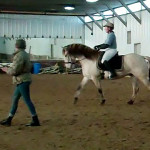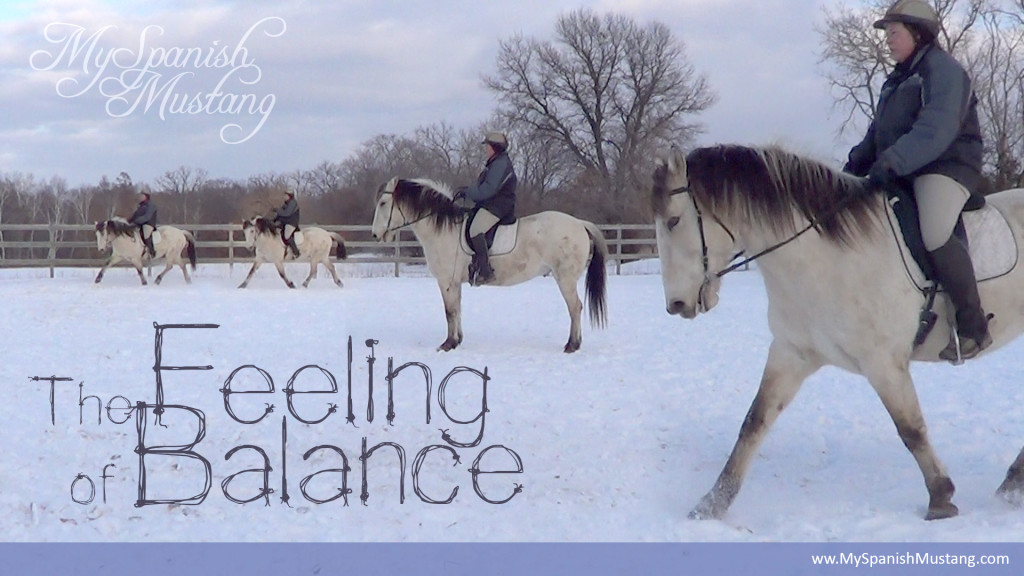By Jennifer Klitzke
High scoring dressage tests award the horse and rider who demonstrate a culmination of rhythm (with energy and tempo), relaxation (elasticity and suppleness), connection (acceptance of the aids and bit), impulsion (energy and thrust, straightness with alignment and balance), and collection (engagement, self carriage, and lightness of the forehand) as they move through a series of gaits, transitions, and movements precisely on the letter. Gait quality, harmony, and submission are factors in scoring, as well as rider’s position and use of aids as they are applied to ride the horse through the required movements of the test.
From time to time I’ve seen “needs more balance” written on dressage tests I’ve ridden. While I know that balance is a dressage essential, I began to explore the “feeling of balance” as I ride my Spanish Mustang Indian’s Legend. What does it feel like when my horse is in balance? What does it feel like when my horse is out of balance? As the rider, how can I identify, restore and maintain my horse’s balance?

This last Fall two of my favorite traveling clinicians came to town. The first was international bio-mechanics riding coach Mary Wanless, who my Spanish Mustang Indian’s Legend (Indy) and I had the privilege of riding with in 2012. The second was successful Grand Prix dressage rider Heather Blitz (who is also a long-time student of Mary’s). While Mary’s clinic helped each rider discover the feeling of a balanced riding position, Heather’s clinic offered metaphors to help rider’s get in touch with the feeling of their horse’s balance and offered terrific training tips whenever their horses lost balance.
In regards to the feeling of balance, Heather encouraged riders to imagine a medicine ball inside the horse’s body while they rode and to notice where the weight of it tends to rest. If it feels like it rests in the horse’s chest then the horse tends to be more on the forehand, and if the medicine ball feels as if it is right beneath the rider’s seat, then that indicates the horse is more in balance with the rider. Indy tends to be a medicine ball in the chest kind of guy.
Heather’s “medicine ball” metaphor has helped me so much in the area of rider awareness as it relates to the feeling of balance. This awareness is an essential first step in guiding Indy to reposition his body into better balance. Whenever he feels like his balance is in his chest instead of beneath my seat, or whenever he leans on the bit or rushes in a quicker tempo, I calmly and quietly half half. If that doesn’t work, then I ask him to halt. And if that doesn’t work then I ask him to halt and softly rein back a couple steps until I feel his balance shift from in front of the saddle to under my seat. Then I calmly and gently cue him forward again.
We practice this at a walk before we proceed to trot, and then canter. The more I remain aware of our balanced, the more balanced steps we have in succession. When we are in sync, it feels like my seat and Indy’s core are connected together like Legos, and we travel together as one unit with power beginning from his hindquarters traveling through his engaged abdomen which lifts his back and withers, and the forward energy flows through my closed hands which push forward towards the bit with a light contact (instead of pulling back).
I am so excited that Spring is right around the corner so that I can begin working these concepts in good footing. Indy and I have made the best of it in the snow on the weekends. Below is a short video of a recent ride. I video record one ride a week as a means to help me see what I feel. This helps me learn. I share this with you in the event any of it helps you in your training of your Spanish Mustang.
Enjoy the journey!
Video: My Spanish Mustang at Trot with Commentary


